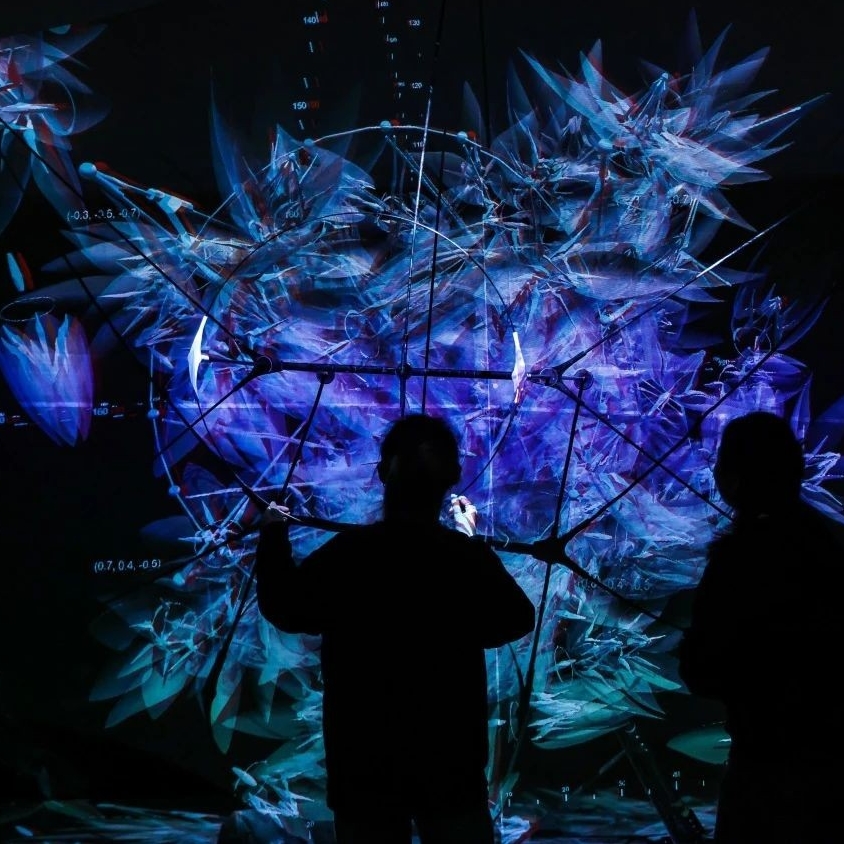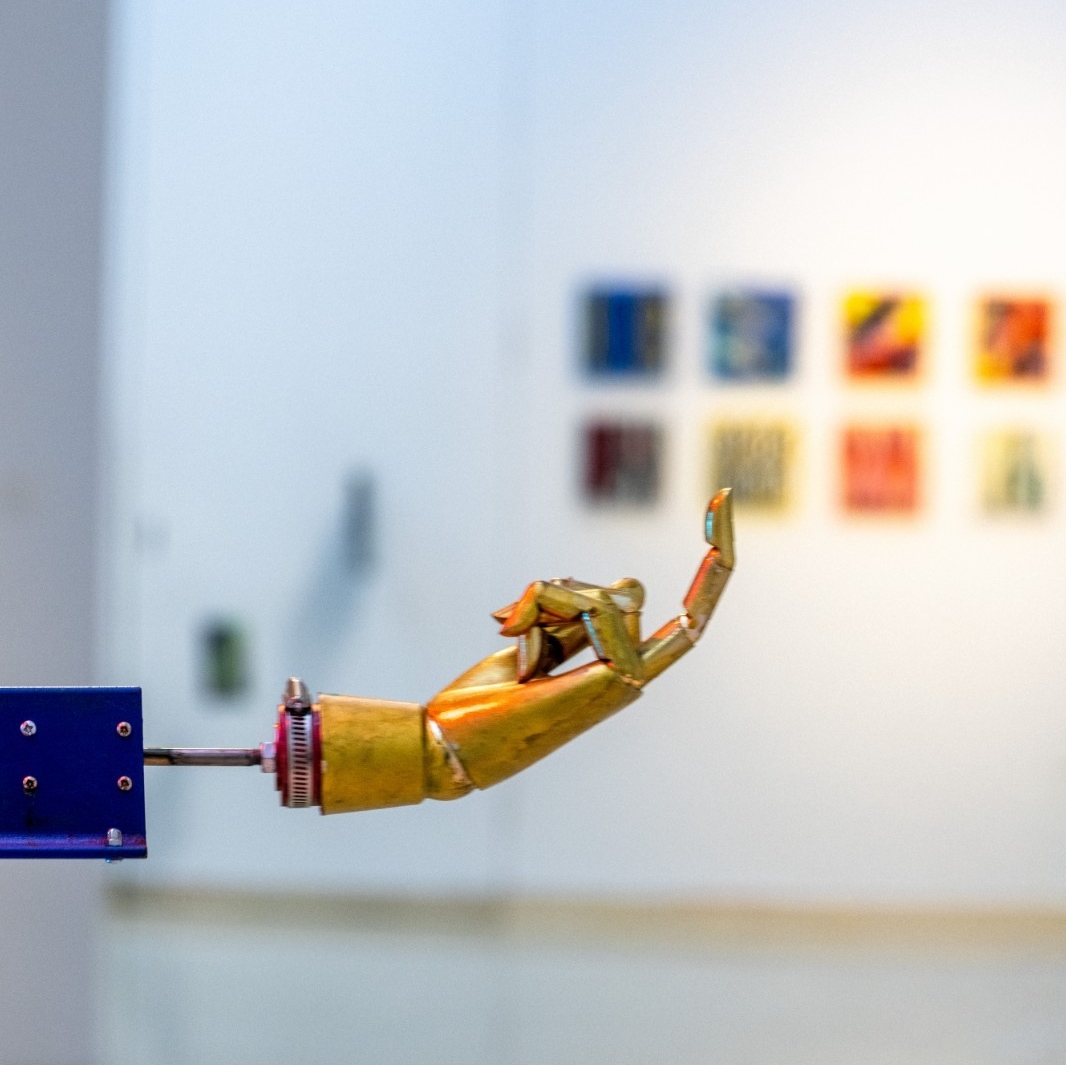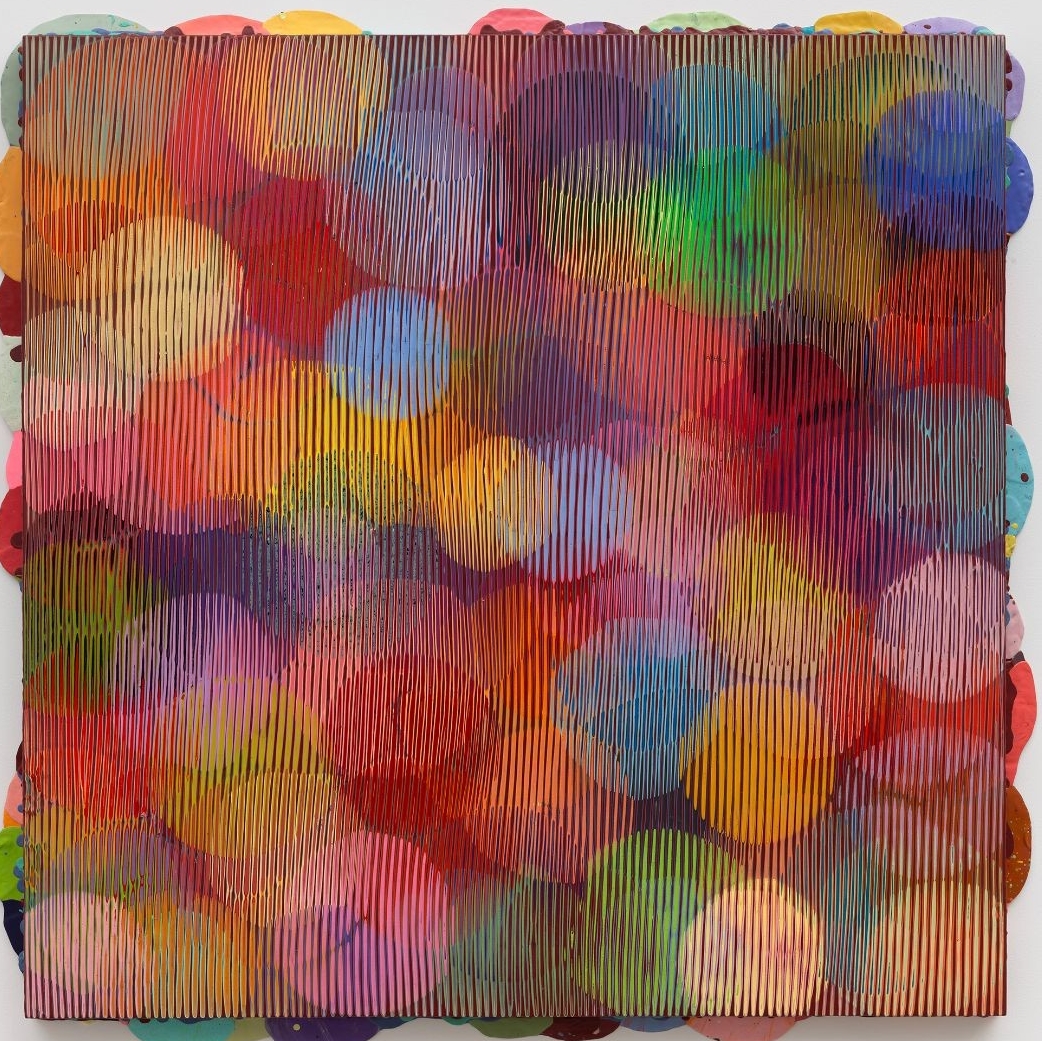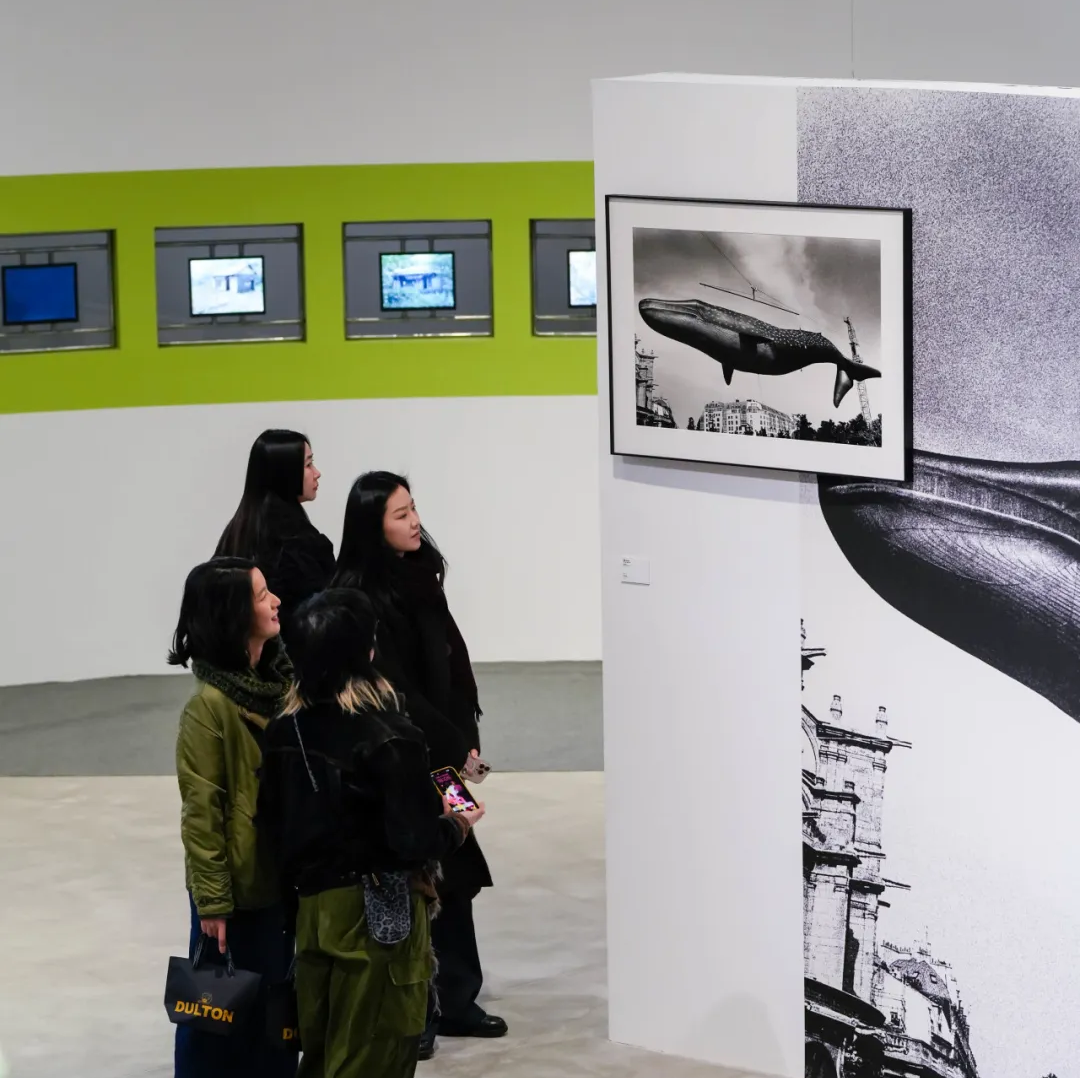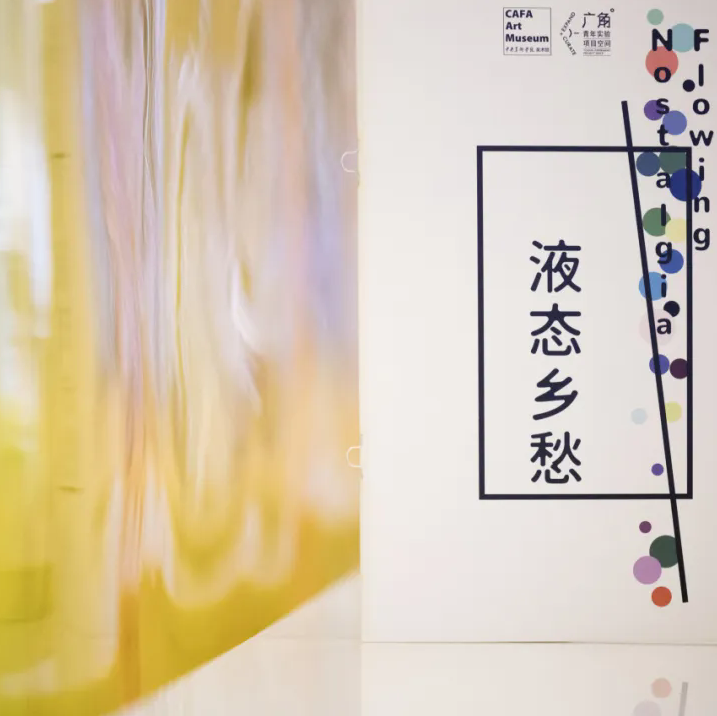 Exhibition View, Courtesy of Shenzhen Museum of Contemporary Art
Exhibition View, Courtesy of Shenzhen Museum of Contemporary Art
Recently, the long-awaited large-scale media art exhibition Topologies of the Real: Techne Shenzhen 2023 had a grand opening at the Shenzhen Museum of Contemporary Art and Urban Planning (MoCAUP). With the venue in Shenzhen, China’s veritable “capital of technology”, what are the implications of this major media art exhibition in the context of the geopolitical significance? What is the urgency of discussing reality through new media when it is prompted and revealed?
I. “Reality Interrupted” and Art in Motion: Masterpieces with and through Media
Topologies of the Real seeks to present three thematic aspects and showcase how media artists throughout history construct and search for new realities in the infinitely expanding and shifting “topologies” of media art. The three parts are titled “Reality Interrupted”, “Datumsoria: The Return of the Real”, and “Multiverse: Ecology without Nature”. The first part includes a parallel presentation of Art in Motion: Masterpieces with and through Media curated by ZKM | Center for Art and Media Karlsruhe, which is touring in China.

 Exhibition View, Courtesy of Shenzhen Museum of Contemporary Art
Exhibition View, Courtesy of Shenzhen Museum of Contemporary Art
The first section, “Reality Interrupted” and Art in Motion: Masterpieces with and through Media, provides an extremely rich, detailed and structured documentation of the early masters of media art history, systematically presenting the work of Dan Graham, Shigeko Kubota, Hans Haacke, Jim Campbell, NAM June Paik, Josef Beuys, Douglas Davis, Phillipe Parreno, Lynn Hershuman Leeson, Wang Gongxin, and Zhang Peili, whose names along with their works have appeared in the art history textbooks taught in colleges.

 Exhibition View, Courtesy of Shenzhen Museum of Contemporary Art
Exhibition View, Courtesy of Shenzhen Museum of Contemporary Art
This section begins with an ambitiously grand yet nuanced narrative on creators with ambiguous identities as filmmakers and media artists, such as Bertolt Brecht and Luis Buñuel. The impact and influence of the rapid development of photographic machinery on art in the early 20th century are then visualised.
 Exhibition View of “Present, Continuous, Past(s)”by Dan Graham, Courtesy of Shenzhen Museum of Contemporary Art
Exhibition View of “Present, Continuous, Past(s)”by Dan Graham, Courtesy of Shenzhen Museum of Contemporary Art
Dan Graham, an avantgarde artist known for his broad creations in conceptual art, video art, video installation and performance art, began exploring video and closed circuits in the 1970s. This exhibition presents his most famous interactive installation, “Present, Continuous, Past(s)”. Also of historical documentary value, including the documentary and installation restorations in this section, is the 1986 film “Reunion Archive” recording the chess match between Marcel Duchamp and John Cage by Shigeko Kubota, a pioneer of early video art and a participant in the Fluxus.
 Exhibition View of “Reunion Archive”by Shigeko Kubota, Courtesy of Shenzhen Museum of Contemporary Art
Exhibition View of “Reunion Archive”by Shigeko Kubota, Courtesy of Shenzhen Museum of Contemporary Art
Based on ZKM’s definition of media art, “motion” is considered central to the character of media art and is utilised to carry the artists’ ideas. “Motion” is not only about the trajectory of the camera, but also about the continuous exploration of mechanical and dynamic beauty by artists such as Laszlo Moholy Nagy. Representative works include the post-minimalist pinnacle “Blue Sail” by Hans Haacke, which is featured prominently in the first section of the gallery.
 Exhibition View of “Blue Sail” by Hans Haacke, Courtesy of Shenzhen Museum of Contemporary Art
Exhibition View of “Blue Sail” by Hans Haacke, Courtesy of Shenzhen Museum of Contemporary Art 10 Exhibition View of “Dialogue”by Wang Gongxin, Courtesy of Shenzhen Museum of Contemporary Art
10 Exhibition View of “Dialogue”by Wang Gongxin, Courtesy of Shenzhen Museum of Contemporary Art
In Wang Gongxin’s “Dialogue”, the “motion” is that of two light bulbs following a specific trajectory, and in Jim Campbell’s “Shadow (for Heisenberg)”, as he explores the medium, it is directly related to that of the human body; the closer the viewer approaches the work, a glass cube containing a statue, the more the cube becomes foggy, and as the viewer steps away, the fog dissipates. “Interaction” as a key feature of media art is derived precisely from the character of “motion”. New technologies bring new ways of motion, and new interactions also arrive, thus a constantly renewed reality.

Exhibition View of “Shadow (for Heisenberg)”by Jim Campbell, Courtesy of Shenzhen Museum of Contemporary Art
In the view of lead curator Zhang Ga, by revisiting the early history of media art, it is discovered that“motion pictures in cinematographic overlays and cybernetic feedback systems further enrich this history, thereby foreshadowing the ubiquitous forms of interaction that exist today.” In the history of media art that lasts over a century, its explosive development came at the very moment when a certain reality was interrupted, and the emerging media, or the “extensions of man” as McLuhan calls them, subsequently constructed new realities.
II. “Datumsoria: The Return of the Real”
While the first section of the exhibition traces the early history of media art, laying out the technological history of its birth and development, the second section centred on “datumsoria” points to a new perceptual space created in the information age, and thus provides the context in which “the Real” in the Topologies of the Real is described and qualified.
 Exhibition View, Courtesy of Shenzhen Museum of Contemporary Art
Exhibition View, Courtesy of Shenzhen Museum of Contemporary Art
As a neologism conjugated from “datum” and sensoria, datumsoria speaks the logic of the new real, a reality predicated on the virtual force of the binary impulse, of the generativity of ones and zeros from whose plane of immanence comes forth a hardening of shapes and forms. The real is neither the quest for reproduction nor the transcendence of reality, but the obscured virtual. 1
 Exhibition View, Courtesy of Shenzhen Museum of Contemporary Art
Exhibition View, Courtesy of Shenzhen Museum of Contemporary Art
The most pertinent work that demonstrates the real as the obscured virtual is Liu Xiaodong’s “Weight of Insomnia (Day and Night, Parkview Green Fangcaodi, Beijing 2023)”. Liu set up cameras in three locations including the Bund in Shanghai, Sanlitun in Beijing and a square in his hometown. The cameras capture the traces left by people, cars, trees and others in the street scenes and convert them into data. It is as if the second-order reality can only emerge by stripping away the presence of the real and generalising the real. In the generic, eternal phase shift, we need new ways to convey the new real of emotional states. Zhang Ga sees this digital generalisation of the real as some kind of “origin of a new reality”.
 Exhibition View of “Weight of Insomnia (Day and Night, Parkview Green Fangcaodi, Beijing 2023)”by Liu Xiaodong, Courtesy of Shenzhen Museum of Contemporary Art
Exhibition View of “Weight of Insomnia (Day and Night, Parkview Green Fangcaodi, Beijing 2023)”by Liu Xiaodong, Courtesy of Shenzhen Museum of Contemporary Art
That is why in this section the exploration of the artists always moves between the real reached via the virtual world and the real created through the interaction of body and space, with the new real often presenting itself as a kind of generative generalisation. The real explored by Jon Kessler in “The Blue Period” is presented in a large immersive installation. Laurent Grass’ “Projection” also interrogates the real, but in a fictional way that can only be achieved and presented through digital video technology.
 Exhibition View of “The Blue Period”by Jon Kessler , Courtesy of Shenzhen Museum of Contemporary Art
Exhibition View of “The Blue Period”by Jon Kessler , Courtesy of Shenzhen Museum of Contemporary Art
Zhang Ga explained how the curatorial ideas of “Real Topology” came forth. In 2008 the exhibition Synthetic Times proposed four concepts that constituted the Synthetic Times nowadays based on technology, namely “Beyond body”, “Emotive digital”, “Recombinant reality”, and “Here, there and everywhere”. The first concept referred to the new status of people under technological conditions. The second was about the new perception of objects under technological conditions. The last two sought to address how digital media and cyberspace had redefined the meaning of reality. The current major exhibition, Topologies of the Real, is clearly a further inquiry into the last two concepts, and an extension of the logic behind the two contemporary phenomena discussed in the two major exhibitions that sparked the boom of new media art in China, namely Translife and Thingworld. This leads the exhibition back to an old philosophical proposition: what is the real? What is real under the technological construction of space and time?
III. “Multiverse: Ecology without Nature”
The third part of the exhibition also features a selection of representative works in the field of media art in China and abroad. “Ecology without Nature” is drawn from Timothy Morton’s book of the same name, in which Morton attempts to examine the formation of the concept of “nature” in Western cultural contexts and critique the subsequent concept of “ecology”.
However, the exhibition does not choose to adopt Morton’s critical view of nature and ecology, but rather focuses on interrogating fixed notions of “cosmos” and “nature”, in order to orient itself towards “a multiverse reality based on speculation, but not unattainable, with entirely different dimensions and matters”. 2 In such a multiverse, free from the constraints of materiality, almost all flourishing fictions and fantasies can be loaded.
 Exhibition View of “Bottle 1, Bottle 4, Bottle 5, Bottle 13, Bottle 17” by Mike Kelley, Courtesy of Shenzhen Museum of Contemporary Art
Exhibition View of “Bottle 1, Bottle 4, Bottle 5, Bottle 13, Bottle 17” by Mike Kelley, Courtesy of Shenzhen Museum of Contemporary Art
In this part of the exhibition, almost all works, including “Bottle 1, Bottle 4, Bottle 5, Bottle 13, Bottle 17” by Mike Kelley, “Dust of Suns II” by Yoonchul Kim, “Time to Nest, Time to Migrate” by Marc Lee, “Unknown” by Yin Xiuzhen, and so forth, demonstrate a strong tendency to imagine, explore and present the “unknown” world through technology.
 Exhibition View of “Dust of Suns II” by Yoonchul Kim, Courtesy of Shenzhen Museum of Contemporary Art
Exhibition View of “Dust of Suns II” by Yoonchul Kim, Courtesy of Shenzhen Museum of Contemporary Art Exhibition View of “Time to Nest, Time to Migrate” by Marc Lee, Courtesy of Shenzhen Museum of Contemporary Art
Exhibition View of “Time to Nest, Time to Migrate” by Marc Lee, Courtesy of Shenzhen Museum of Contemporary Art Exhibition View of “Unknown” by Yin Xiuzhen, Courtesy of Shenzhen Museum of Contemporary Art
Exhibition View of “Unknown” by Yin Xiuzhen, Courtesy of Shenzhen Museum of Contemporary Art
Borrowing the mathematical concept of “topology” for the title, the exhibition features media artists who constantly challenge and expand the boundaries between art and the real in a topology of constantly shifting technologies. The sheer volume of the exhibition—110 works by iconic media artists from the genre’s inception in the 1960s to the present day, spread over a total area of approximately 6,500 square metres (70,000 square feet) across two pavilions in Shenzhen—evidently offers a voluminous historical context.
 Exhibition View, Courtesy of Shenzhen Museum of Contemporary Art
Exhibition View, Courtesy of Shenzhen Museum of Contemporary Art
Whereas the exhibition is a significant retrospective on the history of media art, the issues it raises and conceives take place in Shenzhen, where cutting-edge issues such as technology and ecology are being explored. This provides a fresh context for the exhibition to re-examine the complex history of media art, and in the process of deep dialogue with the city, a certain foresight is derived. It means that how to re-understand and even re-examine in the present time the creative thinking towards art creation shown by previous masters at the beginning of electronic technology in the 1960s embodies the inspiration and expectations for creators nowadays to explore technology and art.
Text (CN) by Mengxi, edited (EN) by Sue/CAFA ART INFO
Image Courtesy of the Organizers
Notes:
1. Datumsoria: The Return of the Real by Zhang Ga
2. Preface for Topologies of the Real: Techne Shenzhen 2023
About the Exhibition

Organized by
Shenzhen Museum of Contemporary Art and Urban Planning
Institute of Sci-Tech Art China Central Academy of Fine Arts
New Media Art Foundation
Academic Affiliation
Central Academy of Fine Arts
In collaboration with
ZKM | Center for Art and Media Karlsruhe
CAFA Art Museum
Art and Technology Innovation Center of BNU
In partnership with
Beijing ZONHOM (Beijing) Cultural Development Co., Ltd
Topologies of the Real: Techne Shenzhen 2023
Curator
ZHANG Ga
ZKM Art in Motion: Masterpieces with and through Media
Curators
Peter Weibel (1944-2023)
Siegfried Zielinski
Daria Mille
ZHANG Ga
Academic Advisor
FAN Di’an
Artistic Advisors
SU Xinping and XIAO Xiangrong
Producers
ZHANG Zikang and YAN Weixin
Executive Producer
SHEN Tianshu
Produced by
YANG Kun, TANG Yu, and YAN Lei
Curatorial Associates
XU Haomin, WANG Jinghan, LUO Shuang, DENG Yao, ZHANG Nan, XU Zhengxu
Assistant Producers
LIU Jiangwei, SHI Yan
Architectural Design
Yifu
Visual Design
JI Yujie, LIANG Bing, GU Hanyun, HU Yibing, LU Xi, LIU Siran
Publicity
XIAO Ge
Coordination
HAO Jialin
Special Acknowledgment
Centre Pompidu, San Francisco Museum of Modern Art, Museum of Modern Art (New York) , Prohelvetia, Shigeko Kubota Video Art Foundation, John Cage Foundation, Paula Cooper gallery, Esther Schipper gallery, Eigen+Art gallery, bitforms gallery, Pace gallery, Chronus Art Center, Lisson gallery, Mike Kelley Foundation for the Arts, AIKE gallery, MadeIn gallery, ShanghART gallery, Zhi Art Museum, By Art Matters Museum, BANK MABSOCIETY, Postmasters Gallery, Andrew Kreps gallery, Electronic Arts Intermix, Tallieu Art Office, Galerie Elisabeth & Klaus Thoman, Sadie Coles HQ gallery
Exhibition Execution
SANG Hui, XU Zixian, XUE Xintian, ZUO Yilei, HU Siyu
Installation Supervision
FANG Fuyou, LUO Minchao, LI Wenjia, XU Zihan
Shenzhen Museum of Contemporary Art and Urban Planning
LI Kechun, ZHOU Ning, SUN Baoping, ZHANG Yun, LI Xiaoyu, SUN Lin, YAN Yulan, CHEN Yan, LIAO Danyu, KE Zhihong, ZHANG Junrong, ZHANG Jianan, LIN Yishan
Beijing ZONHOM Arts and Cultural Development Co., Ltd
JIA Mingzhun, ZHANG Yiwei, HU Yi, FANG Linyun, GUO Zhiang, LI Wanjing, LI Zihao, GE Jiabao, XIN Zhuolei, LU Bing, FAN Huibing, SU Shenyu, LI Jianhua, JIA Jianshu
Special Thanks
CHAI Zhikun, HU Dong


